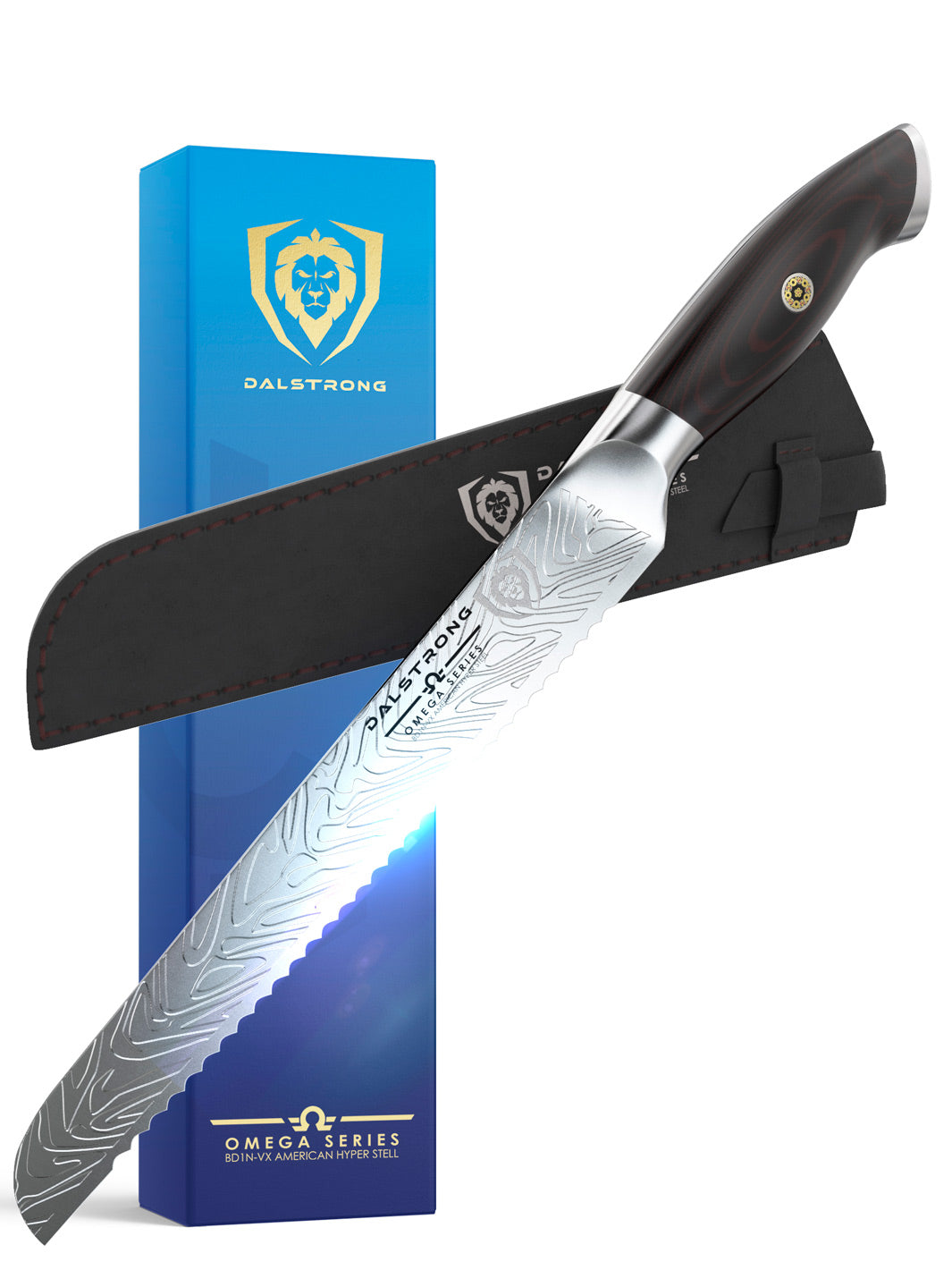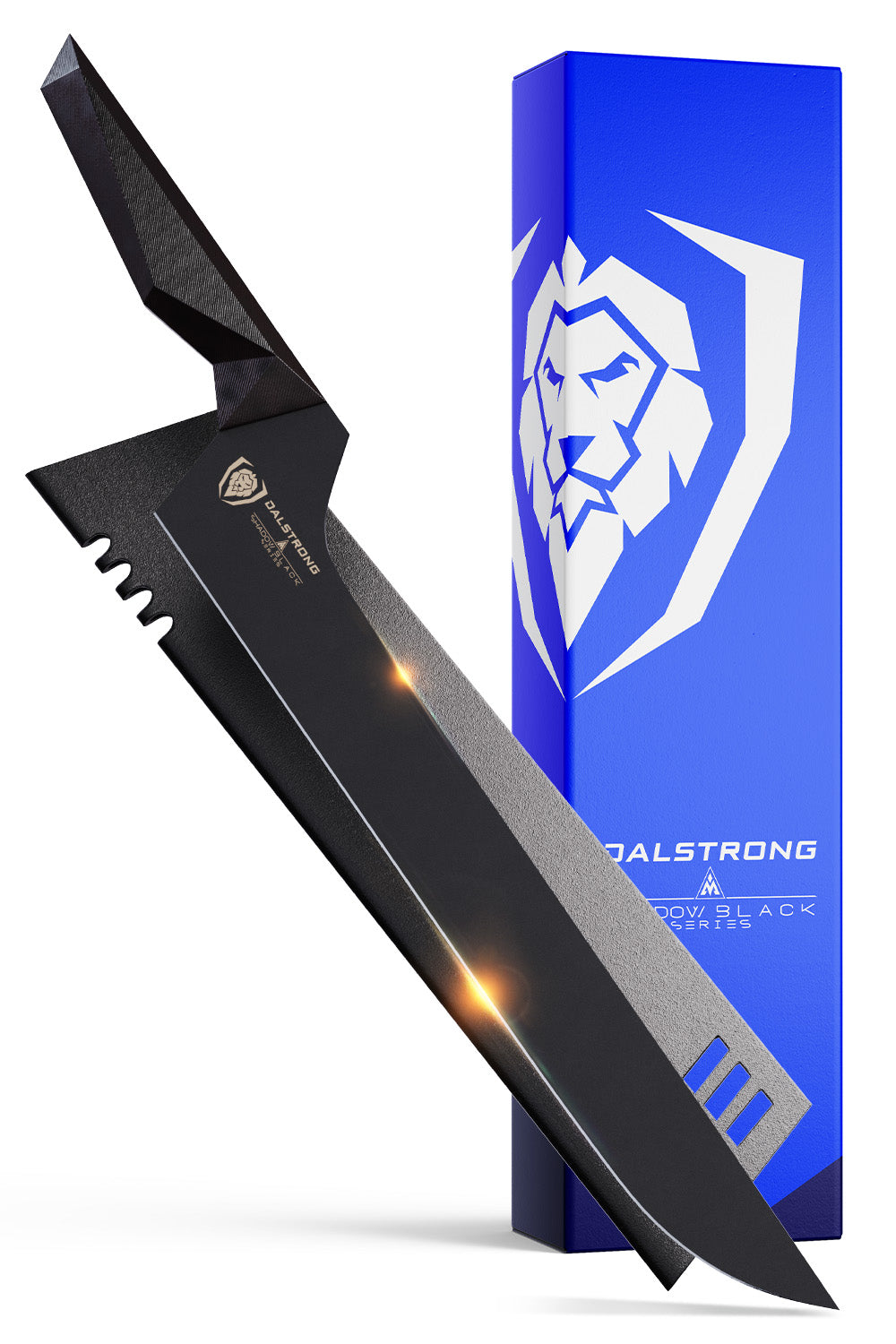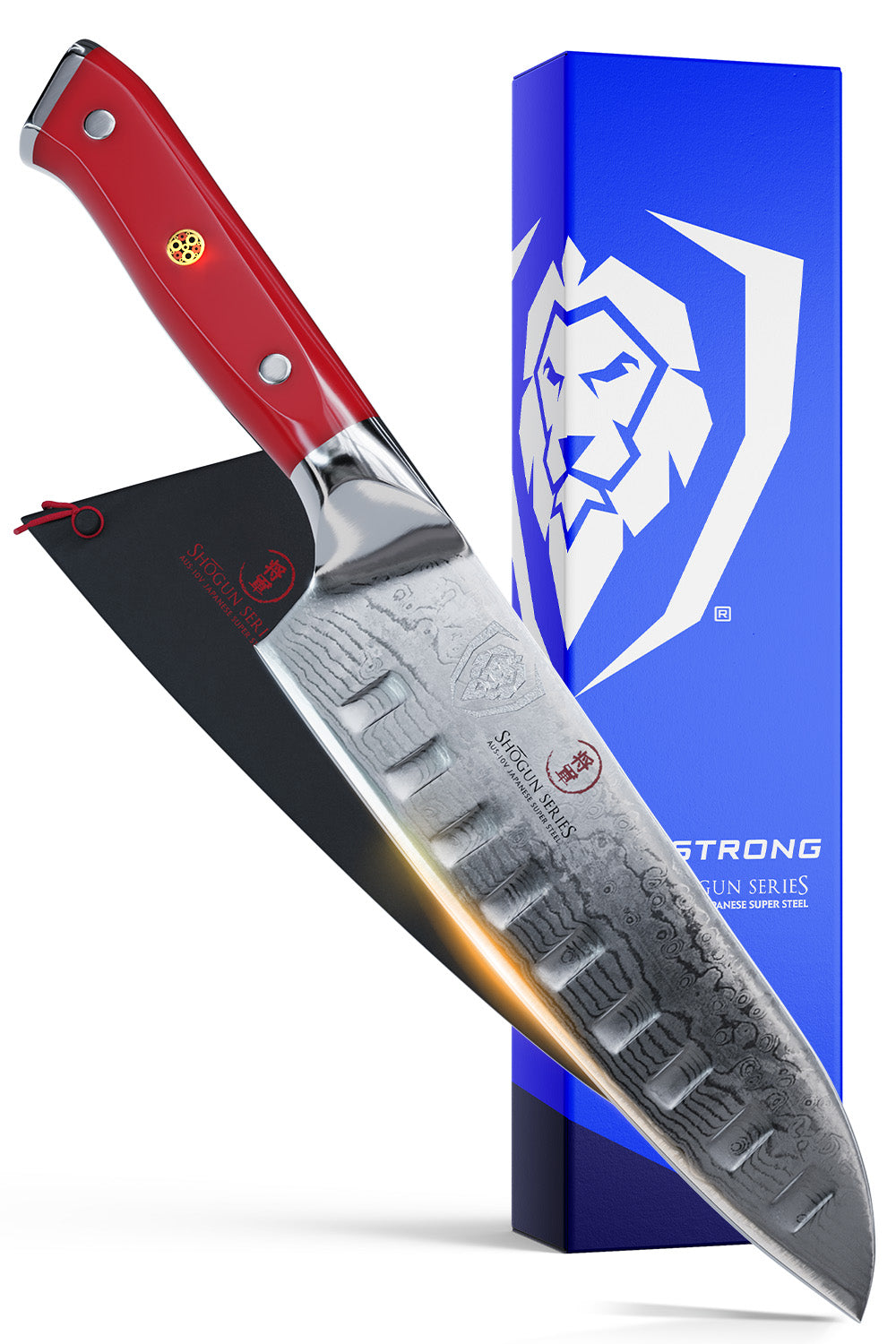 Santoku Knife 7" Shogun Series ELITE | Dalstrong
Santoku Knife 7" Shogun Series ELITE | Dalstrong
Knife skills are about more than just showing off. Having the right skills can make you a better, safer, and more confident cook.
1. Why Knife Skills Are Important
 Santoku Knife 7" Shogun Series ELITE
Santoku Knife 7" Shogun Series ELITE
We've all been there: Staring enviously at the mesmerizing, swift chopping techniques of professional chefs while watching cooking shows or browsing Serious Eats. Perhaps you've been in awe of students from the Escoffier School of Culinary Arts, chopping, dicing, and julienning with the finesse of a maestro. But did you know that these techniques, seemingly reserved for the crème de la crème of the culinary world, can easily be your secret weapon in the kitchen too?
Safety and efficiency
Here's the thing – knife skills aren't just about looking cool (although they do). They're about efficiency and safety. A sharp knife and the knowledge of how to use it reduces the risk of accidents in the kitchen. It's the hesitant, unsure cuts that often lead to slips and nicks.
A chef or home cook that knows how to properly move the knife and manage basic knife cuts can save heaps of time. We're talking minutes shaved off every vegetable, every piece of meat and poultry, every fruit... minutes that add up. Before you know it, you've saved enough time for an extra episode of that Netflix show you've been binging!
Better cooking
But it's not just about speed. Proper knife skills ensure even-sized pieces, which means your food cooks at a uniform rate. No more half-crunchy, half-mushy potatoes!
Presentation matters
When your diced onions resemble neat little cubes and your julienned carrots are uniform, your dishes don't just taste good – they look professional. And let's be honest, there's a special kind of pride when your guests (or even just your cat) give that look of "Did you really make this yourself?"
So the next time you hesitate about investing time in learning those essential culinary knife skills, remember: it's a skill that pays back in saved time, safety, uniform cooking, and sheer culinary beauty.
2. How To Properly Hold A Knife
Knowing how to hold a knife is the bedrock of all knife skills and techniques. It's the unsung hero of quick, efficient, and -- most importantly -- safe meal prep.
First things first, forget those over-exaggerated, white-knuckled grips you've seen in horror movies or that time you tried to mimic that dramatic scene from a movie or cooking show (we've all been there). In the real world of home chefs and professional cooks, wielding a chef's knife is an art, not a theatrical performance. And the cornerstone of this art? The "claw grip."
What is the "claw grip"?
Despite its slightly intimidating name (sounds like a secret kung fu move, doesn’t it?), the claw grip is all about safety and precision. Imagine you're showing off a new, dazzling ring on your index finger. Now, place that finger slightly curled on the side of the knife's blade, closer to the base. Your thumb does the same thing but on the opposite side of the blade. The rest of your fingers? They take a relaxed approach, wrapping snugly around the knife's handle.
As far as your food item, hold it with your other hand. Curl your fingers inward, similar to making a claw with your hand, so that your fingertips are tucked under and your knuckles are facing forward. Your knuckles, particularly the knuckles of your middle and index fingers, serve as a guide for the side of the knife blade, allowing you to move the blade up and down in a controlled manner without the risk of cutting your fingertips.
By keeping your fingers close to the blade and guiding your knife with your other hand's knuckles, you're essentially becoming one with your knife. The knife becomes an extension of your hand, giving you a level of control that a more distant grip can never offer. Those finely chopped herbs or that perfectly julienned bell pepper? They're all achievable when you and your knife move as a cohesive unit.
Safety
With the claw grip, your fingers are safely tucked away from the knife's path. And the chances of accidentally nicking your fingers reduce dramatically. The Kenji López-Alt's and culinary school stars of the world didn't get there with band-aids on every finger, and neither should you!
Endurance
If you've ever had to chop a mountain of veggies for a family feast, you know it can be quite the arm workout. The claw grip reduces hand fatigue. It ensures that the effort is distributed, meaning you can prep longer without your hand feeling like it just did a marathon.
Look the part
Let's not skirt around this -- using the claw grip makes you look like you know your way around the kitchen. Next time you're cooking with friends or family, whip out your chef's knife, assume the claw grip, and watch those impressed eyebrows raise.
Apart from the elegant claw grip, there are several other knife grips that are popularly used in the culinary world. Each grip has its specific applications, advantages, and preferred usage scenarios. Let's delve into some of them:
Pinch grip
The pinch grip is a fundamental knife-handling technique favored by many professional chefs for its precision and safety. To achieve this grip, hold the knife handle with your dominant hand, and use your thumb and the initial joint of your index finger to "pinch" the knife blade right where it meets the handle, often referred to as the "bolster" or "choil." The remaining three fingers then wrap around the knife's handle.
This method not only provides superior control, but also distributes the knife's weight across the hand. Like the claw grip, the pinch grip is a skill taught in culinary schools, and while it might feel unfamiliar at first, regular practice makes it second nature in the kitchen.
Handle grip
This one's more intuitive for many beginners: Simply grasp the knife’s handle with all five fingers, wrapping them around the handle. Your thumb rests against one side of the handle, while your fingers curl around the other. It's often more comfortable for those new to knife skills, and it offers more power for cuts requiring strength, like going through tough meat or large vegetables.
Pencil grip
This grip is for delicate tasks. Hold the knife like you would a pencil, near the tip. The thumb is on one side, the index and middle finger on the other, and the rest of the fingers are tucked away. It's perfect for tasks requiring finesse, such as peeling fruits or making intricate vegetable carvings. It also allows for a light touch and precise control.
3. Basic Cutting Techniques
 Chef's Knife 9.5" Shogun Series ELITE | Dalstrong
Chef's Knife 9.5" Shogun Series ELITE | Dalstrong
Rock chop
Sounds like a dance sensation from the 1950s. The rock chop is a fundamental skill that every home cook should master. Picture this: your hand forms a claw grip on the food, ensuring your fingertips are safe, while the other hand holds the knife. The tip of the knife's blade remains in constant contact with the cutting board, rocking back and forth. Imagine the motion of a seesaw, but more culinary and less playground. The rocking motion is not only rhythmic and therapeutic but also efficient for mincing items like garlic and herbs, ensuring they retain their flavor without being mashed.
Julienne cut
The Julienne cut is essentially making your veggies and other food items resemble matchsticks. Sounds simple, but achieving those uniform thin strips requires patience and precision. Remember the last time you tried to impress a date with a homemade fancy stir-fry? Those thinly sliced veggies that cooked evenly and looked straight out of a gourmet kitchen? That’s the magic of the Julienne.
Dice an onion
Ah, the age-old teary task. Here's the trick: begin by cutting off the onion’s ends and halving it. Then, make vertical cuts without slicing through the back, followed by horizontal ones. As you then proceed to dice, you’ll find uniform pieces falling away. And a sharp knife reduces the onion's cell damage, meaning fewer irritants released. But if you still shed a tear, just tell your audience it's because of the sheer beauty of your perfect dice. After all, even chefs can become overwhelmed with emotion.
4. Tips To Improve Your Knife Skills
 Kiritsuke Chef's Knife 9.5" Phantom Series
Kiritsuke Chef's Knife 9.5" Phantom Series
Here are some tips to help you grow your knife skills.
Keep your blade sharp
This is for safety as well as ease. When you try to cut food with a blunt blade, you're not so much cutting as you are tearing, and this can make your dishes look less appetizing and can also affect the cooking process. Remember, with great power (a sharp knife) comes great responsibility (to keep it sharp).
Practice, practice, practice
As they say, Rome wasn't built in a day. Neither are impeccable knife skills. Every slice, dice, and julienne is an opportunity to refine your technique. Kenji López-Alt from Serious Eats nailed it with his analogy. If your cutting board looks like a crime scene after dicing an onion, you probably need a little more practice. But don't be disheartened! Even the most renowned chefs had to start somewhere. Each cut brings you one step closer to that perfect julienne or that impeccable dice.
Hold your ground (and your knife)
When you're in the throes of culinary passion, dicing, slicing, and rocking, it's easy to get carried away. However, it's crucial to maintain a proper stance and grip. Plant your feet shoulder-width apart, relax your shoulders, and let the knife do the work. Your hand should move the knife, not your entire arm. This gives you better control and reduces fatigue.
Embrace the tech
Today's digital age offers a plethora of resources. From video tutorials to articles and even virtual classes, platforms like Serious Eats provide invaluable insights and lessons. Kenji López-Alt, among other culinary maestros, regularly shares tips and tricks that can take your skills to the next level.
To sum it up, the journey to knife mastery is filled with slices, dices, a few nicks, and a whole lot of passion. With dedication, the right tools, and perhaps a bit of guidance from the pros, you'll be wielding that chef's knife like a maestro in no time. And when that happens, the culinary world is your oyster -- or, in this case, your perfectly shucked oyster.
Read about the best way to clean your knives, here.
5. Dalstrong Tools To Practice Your Knife Skills
1. Chef's Knife 8" | Spartan Ghost Series | Dalstrong

This is a knife unlike any other you've seen before. The new Dalstrong Spartan Ghost Series 8" Chef's Knife is a perfect blend of advanced metallurgy and incredible design. Meticulously crafted from ultra-premium powdered S35VN steel, this knife is extremely sharp and durable. Its sleek design, accentuated with a blood-red resin and ghost-ash black stabilized wood handle, is a nod to its Spartan warrior inspiration, making it as much a piece of art as it is a culinary instrument.
PROS:
- Engineered from ultra-premium powdered S35VN steel, guaranteeing a razor-sharp edge and unmatched durability.
- Enhanced with Dalstrong's signature black DLC LionArmor coating, providing resistance against moisture, acids, and general wear-and-tear.
- The advanced D3 sharpening process ensures maximum sharpness and precision with each cut.
- A beautifully designed blood-red resin and ghost-ash black stabilized wood handle ensures a comfortable, non-slip grip.
CONS:
- With its luxury features and materials, this knife might be a significant investment for some home cooks.
- The unique design is stunning but may not fit every home cook's personal taste.
2. Fillet Knife 6" | Shogun Series ELITE | Dalstrong
Fillet knives are perfect for filleting, skinning, and deboning, and this one's one of the best you'll find. Crafted to ensure a clean separation of tissue from bone and skin, this knife's slender, curved blade, optimized for minimal drag, combines both the finesse of agility and the strength of performance. Not only that, but it looks amazing.
PROS:
- Precision forged from ultra-premium Japanese AUS-10V steel, ensuring stellar performance and remarkable edge retention.
- Features a 2.0mm thick blade, it offers a harmonious blend of flexibility and strength for delicate tasks.
- The ergonomic handle, constructed from G-10 Garolite, promises military-grade durability while ensuring superior hand control and comfort.
-
Elegant and fierce. One of the best-looking knives you'll find.
CONS:
- Its sharpness and design might require a learning curve for those new to using premium knives.
- If you're looking for a more versatile knife, look into getting a chefs knife instead.
3. Paring Knife 3.5" | Gladiator Series | NSF Certified | Dalstrong

Paring knives are great for tasks that require precision, such as peeling fruits, mincing herbs and making intricate cuts in food. This 3.5" paring knife is crafted from high carbon German Steel, which means it's sharp and resilient. Meanwhile, the ergonomically designed handle, made from G-10 Garolite, offers both durability and comfort. This knife is functional as well as beautifully crafted; every cut is a pleasure.
PROS:
- Precision-forged from high carbon German Steel, ensuring sharpness, wear resistance, and robustness.
- The knife's design ensures optimal balance, allowing for precision cuts and easy handling in diverse culinary tasks.
- The handle, constructed from military-grade G-10 Garolite, looks great and is impervious to heat and moisture.
- Amazing value for the price.
CONS:
- The knife's high sharpness level might make it prone to chipping if not used correctly or if dropped.
- Some home cooks might find it a little heavy compared to standard stainless steel alternatives.
4. Kiritsuke Chef's Knife 9.5" | Phantom Series | Dalstrong
This kiritsuke chef's knife features a sword-like front end that isn't just for show; it’s designed to give you some serious slicing action. Whether you're taking on veggies or fish, this blade's got your back. Made from Japanese AUS-8 steel, it's got "sharp" in its DNA. The knife's got some flair too with its red spacer and copper and brass details. Oh, and it comes with a sleek sheath to keep it safe when you're not using it.
PROS:
- Made from single-piece Japanese AUS-8 steel – it's tough, stain-resistant, and keeps its edge for ages.
- Its design is all about ease, making slicing and dicing feel like a breeze.
- The D-shaped handle is super comfortable and gives you all the control you need.
- It's a looker! The red spacer and shiny details make it stand out in any kitchen.
CONS:
- Its unique kiritsuke style might take a minute to get used to if you're a traditional chef knife user.
- You'll have to up your chopping game with the knife skills outlined in this article.
5. Cleaver Knife 7" | Shogun Series ELITE | Dalstrong
Meet the Shogun Series Elite 7” cleaver. This guy loves to tackle boneless meats, poultry, and those tough veggies and fruits that your regular knives shy away from. Need to mince ginger or garlic? Use the spine of the blade. Want precision in every chop? That flat edge is all about contact with your cutting board. And with an extra wide blade, your knuckles can breathe easy while you slice and dice. You'll really put your knife skills to the test with this tool..
PROS:
- The 7” precision forged blade is made with ultra-premium Japanese AUS-10V ‘super steel’ for a crazy sharp edge that sticks around.
- It's got a killer look with the Shogun Series Tsunami Rose blade pattern.
- With its ergonomic, military-grade G-10 Garolite handle, you're in for a comfy grip that's built to last.
- The knife comes with its own premium sheath.
CONS:
- Remember: this is a cleaver. So it has cleaver proportions. If you're looking for something smaller or more narrow, check out the other knives in this list.
- Prepare for some kitchen envy from friends.
6. Frequently Asked Questions
Is the claw hand technique important?
The claw hand technique is a foundational skill in the culinary world, ensuring safety and precision while you chop. Using this method, you not only prevent accidental cuts but also achieve more consistent results in your chopping. So, unless you like the idea of your finger being an unexpected ingredient, mastering the claw hand is non-negotiable.
What are the 5 basic knife skills?
The five basic knife skills that every home chef should master are:Chopping, Slicing, Dicing, Julienne, Mincing.
What are the proper knife skills?
Proper knife skills are foundational techniques that ensure safety, efficiency, and consistent results in the kitchen. These include: Holding the knife correctly using the claw grip. Maintaining a sharp blade, as a blunt knife can be more dangerous than a sharp one. Using appropriate cutting boards and ensuring they are stable. Mastering basic cutting techniques such as chopping, slicing, dicing, julienne, and mincing.












